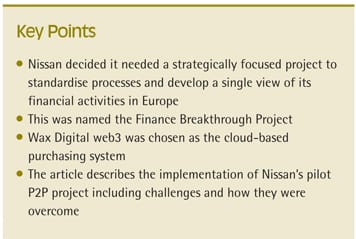After the Ballots
How the ‘year of elections’ reshaped treasury priorities
Published: May 01, 2013

 Nissan Europe is a major subsidiary of the Nissan Motor Company, Ltd and is a key contributor to the company’s objective to achieve global market share of 8% and an 8% increase in operating profit by 2016. In addition to developing and distributing innovative and well-designed vehicles that meet customers’ needs, the company is committed to enhancing its internal processes to increase efficiency whilst also reducing costs wherever possible. This article outlines some of the initiatives that Nissan Europe is undertaking to achieve its financial process efficiency objectives, under the banner of the Finance Breakthrough Project, one of the first components of which has been purchase-to-pay.
Nissan Europe is a major subsidiary of the Nissan Motor Company, Ltd and is a key contributor to the company’s objective to achieve global market share of 8% and an 8% increase in operating profit by 2016. In addition to developing and distributing innovative and well-designed vehicles that meet customers’ needs, the company is committed to enhancing its internal processes to increase efficiency whilst also reducing costs wherever possible. This article outlines some of the initiatives that Nissan Europe is undertaking to achieve its financial process efficiency objectives, under the banner of the Finance Breakthrough Project, one of the first components of which has been purchase-to-pay.
The Nissan Group is organised on a regional basis: Europe; Asia and the Americas. Within the European business, we operate in more than 20 countries. In the past, sales operations in each country have been managed relatively autonomously; in addition, we have three European production facilities in Sunderland, UK, Barcelona, Spain and St Petersburg, Russia. Consequently, the business was largely decentralised, with disparate financial and management reporting.
Over the past ten years, we have gradually increased the degree of centralisation in our European business functions. As our head office reporting requirements have increased, there has been more pressure to standardise formats, processes and policies, which is difficult to achieve in a decentralised environment, particularly as each entity typically had different systems and procedures in place. In addition, we recognised the potential benefits in terms of efficiency, control and rationalisation.

Initially, we made a few attempts to centralise and standardise certain business activities, such as creating a single chart of accounts. However, these initiatives had mixed success. Consequently, we recognised that we needed a more strategically focused project with senior management support in order to standardise our processes, rationalise the use of technology and develop a single, accurate view of our financial activities across the region. This was termed the Finance Breakthrough Project.
The Finance Breakthrough Project is now in the final stages of design. We first evaluated all of our current finance processes in Europe, and we are now completing the design of our ‘to be’ processes at a high level. We will then scope these processes, and the systems that will underpin them, at a more detailed level. One of the first areas on which we have focused is purchase-to-pay (P2P), a key pillar of our Finance Breakthrough Project. We are further ahead with this project than other areas of finance, and our new processes and systems were rolled out as a pilot project in Central & Eastern Europe in the spring of 2013.[[[PAGE]]]
We already had purchasing systems in place but these had been acquired some years previously and were not integrated with SAP. We therefore considered possible replacements and ultimately selected Wax Digital web3. There were a variety of reasons for this decision:
Suppliers would be able to load invoices directly onto the portal, as opposed to sending them to disparate locations within Nissan Europe, avoiding the problems of loss and misdirection that led to payment delays and supplier dissatisfaction. Furthermore, greater visibility and control over P2P processes and information flows would lead to enhanced working capital management and cash flow forecasting. It is our objective to convert as many invoices as possible from paper to electronic format for automated processing.
Before implementing web3, there were some limitations in our P2P workflow, which the new solution enables us to address. Approval processes are more robust, and we can build in expenditure limits by account code, cost centre and project, together with limit utilisation tracking. The system is also closely integrated with our ERP, with a high level of data integrity. This is vital in developing user and management trust in the system. Once implemented, web3 will enable employees to raise requisitions electronically, the relevant approvals will be completed, and approved orders issued automatically to suppliers.

As we reach the end of implementation for the P2P pilot project, we have experienced a variety of implementation challenges, and in some cases, we are continuing to work through them. These include:
Regional diversity
Different legal requirements exist in each of the CEE countries, and the rules around electronic invoicing can differ, such as in Russia where it is not yet possible. To address this, we have developed efficient paper-based invoicing processes in these situations, with hard-copy documents then scanned and processed in the same way as electronic invoices.
Data migration
The work involved to migrate from disparate manual processes and data sets to a single, centralised process and data repository is considerable, not least because the starting point for the migration process differs in each case. For example, we are currently working on the migration of vendor details, such as rules, users, interfaces and data mapping to the chart of accounts.
Testing
Testing is vital to a successful project, and end users need to be engaged in this process. This will be an on-going process during the final few weeks of the pilot project.
Securing resources
It is often difficult to secure the appropriate resources for a diverse, long-term project without compromising other priorities. We have a small project team of four or five people, including representatives from purchasing and finance, which together has managed process design, project management, user workshops and co-ordinated all other activities associated with the project.
Once the pilot project has been completed, and we roll out web3 more widely across Europe, we will have standardised and automated our P2P processes across 3,000 users in more than 20 countries. The system will support multiple languages and currencies and ultimately process 600,000 invoices each year. The implementation is leading to greater efficiency, control, business intelligence and cost savings. This is integral to our Nissan Power 88 midterm business plan which aims to achieve a global market share of 8% and increase our operating profit by 8% by 2016.